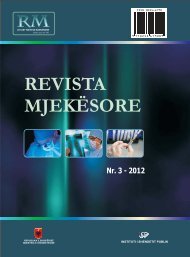in Albania - Instituti i Shendetit Publik
in Albania - Instituti i Shendetit Publik
in Albania - Instituti i Shendetit Publik
You also want an ePaper? Increase the reach of your titles
YUMPU automatically turns print PDFs into web optimized ePapers that Google loves.
ALBANIAN MEDICAL JOURNAL SUPPLEMENTLevel of hand hygiene <strong>in</strong> health care services <strong>in</strong>VloraAgron Bashllari 1 , Mar<strong>in</strong>ela Zejno 2 , Elona Agalliu 11Epidemiology Service, Public Health Directorate, Vlora, <strong>Albania</strong>;2Vlora Regional Hospital.Aim: Hand hygiene is an important element of thequality of health care services. Our aim was todescribe the level of hand hygiene <strong>in</strong> Vlora RegionalHospital.Methods: This was a descriptive study undertakenbetween December 2012 and January 2013 <strong>in</strong>clud<strong>in</strong>ga representative sample of the personnel (n=200).A standardized WHO-recommended questionnairewas adm<strong>in</strong>istered to all participants. Epi-Info wasused for data analysis.Results:· 97% (95%CI=94.6%-99.3%) of participantsreported there is non-stop runn<strong>in</strong>g (safe) water <strong>in</strong>the hospital.· Conversely, 93.5% (95%CI=90.0%-96.8%) of<strong>in</strong>dividuals reported that there were no papernapk<strong>in</strong>s of s<strong>in</strong>gle usage.· 69.3% (95%CI=63.0%-75.6%) of <strong>in</strong>tervieweesreported that the <strong>in</strong>stitution has no real plan forimprov<strong>in</strong>g the <strong>in</strong>frastructure for hand hygiene.· 90% (95%CI=85.0%-94.0%) of <strong>in</strong>dividualsreported that there is no monitor<strong>in</strong>g mechanism ofthe compliance of hand hygiene with<strong>in</strong> the hospital.· Only 6% (95% CI 3.3% -9.9%) of the <strong>in</strong>terviewedpersonnel reported wash<strong>in</strong>g always theirhands before visit<strong>in</strong>g/treat<strong>in</strong>g patients.· The hand hygiene compliance rate for the item:before visit<strong>in</strong>g/ treat<strong>in</strong>g the patient was 3%.Conclusions: Our f<strong>in</strong>d<strong>in</strong>gs po<strong>in</strong>t to the urgent needfor implementation of the program for handhygiene, accord<strong>in</strong>g to WHO guidel<strong>in</strong>es. Furthermore,there is a need for prioritization of possible<strong>in</strong>terventions concern<strong>in</strong>g: <strong>in</strong>frastructure; cont<strong>in</strong>uoustra<strong>in</strong><strong>in</strong>g of personnel; promotional campaigns;evaluation and feedback of <strong>in</strong>formation on handhygiene; establishment of a positive <strong>in</strong>stitutionalclimate about the issue of hand hygiene by engag<strong>in</strong>gthe lead<strong>in</strong>g staff of the hospital.Keywords: hand hygiene, health careservices, V lora.100 ALBANIAN MEDICAL JOURNAL SUPPLEMENT




